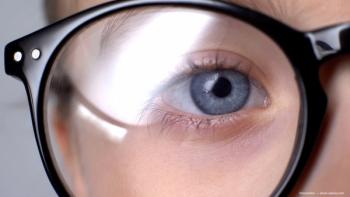
Novel accommodating IOL achieves unique level of accommodative change
A prototype of a novel dual-mode, accommodating-disaccommodating intraocular lens with zonular capture haptics has been fabricated successfully. The lens has shown in bench studies to exhibit axial shift and shape change that results in up to about 26 D of accommodative change,
By Cheryl Guttman Krader, Reviewed by Paul M. Beer, MD.
A prototype of a novel dual-mode, accommodating-disaccommodating intraocular lens (AD-IOL) with zonular capture haptics has been fabricated successfully and the lens has shown in bench studies to exhibit axial shift and shape change that results in up to about 26 D of accommodative change, reported Paul M. Beer, MD.
Dr. Beer invented the technology and is founder and CEO of Z Lens LLC, St. Petersburg, FL, the company developing the AD-IOL for commercialization. The AD-IOL is intended for in-the-bag implantation and features a flexible, fluid-filled optic driven by four haptics that are captured by the zonules.
The haptics attach to the anterior portion of the optic–which is the deforming accommodative component–while the posterior portion of the optic, which contains the aphakic prescription, maintains a fixed shape.
“Movement of the crystalline lens is essential for accommodative function,” Dr. Beer explained. “My goal for developing a presbyopia-correcting IOL has been to replicate that movement. Our AD-IOL technology is the only accommodating IOL platform that has been proven to capture the movement.”
Advance to primates
The next step in the development of the AD-IOL will be to confirm the results observed in bench studies in eyes of living primates. The AD-IOL procedure involves two stages. First, the lens is implanted in the bag by applying the same technique as for a standard monofocal IOL.
Dual-mode AD-IOL sized for a primate eye, next to a dime. The IOL is similar in size and thickness to a standard monofocal IOL. (Image courtesy of Paul Beer, MD)
“The IOL is the same size as a regular IOL,” Dr. Beer said. “It is locked in a flattened, disaccommodated configuration.”
After allowing four to six weeks for the capsule to collapse, fibrose, and adhere to the haptics, the IOL is unlocked. Radial capsulotomies are created in a non-invasive procedure using a laser (Nd:YAG or femtosecond), releasing optic mobility.
Research conducted with the first version of the accommodating IOL, designed to achieve axial shift with accommodation/disaccommodation, proved that the zonular capture haptics could convert zonular force into optic movement. However, as expected, the axial-shifting AD-IOL exhibited a limited range of accommodation.
“Zonular-capture haptics is an enabling technology that can be used in different ways,” Dr. Beer explained. “The dual-mode AD-IOL is designed to achieve both axial shift and an optic shape change with a system that can work in a closed and fibrosed capsular bag to achieve at least 15 D of accommodative change in the eye at the same force level as the previous model.”
Initial testing
Initial testing of the dual-mode AD-IOL was performed by Adrian Glasser, PhD, Lions Eye Institute for Transplant and Research, Tampa, FL. The IOL was placed on a motorized stretcher in a mechanical eye model. Wavefront recordings were obtained using ray-tracing aberrometry (iTrace, Tracey Technologies) at baseline and when the IOL was stretched 0.6 mm, 0.8 mm, and 1.0 mm.
Dual-mode AD-IOL wavefronts analysis at various stretch levels. (Chart courtesy of Paul Beer, MD)
The evaluation showed visible movement of the haptics and optic with greater movement in the center of the optic than in the periphery. There was no significant distortion of the wavefront map across the range of stretch investigated.
“This experiment successfully addressed potential concern that change in optic shape would significantly distort optical quality,” said Dr. Beer.
“In finite element analysis, it was also shown that most of the strain in the optic occurred at the outer edges rather than in the center that moves up and down,” he added. “This reflects our clever design that enables significant change in optic shape with the low amount of force produced by the zonules.”
Second evaluation
A second evaluation of the dual-mode AD-IOL was performed by another independent laboratory (Photon Gear Inc.), using Twyman-Green laser interferometry to evaluate change in power with stretching. Again, progressive flattening of the top of the optic was seen with stretching to 0.4 mm and 0.8 mm. Power changed from 34 D in the accommodated state (0 mm stretch) to 8 D at the maximum stretch tested (0.8 mm).
“The interferometer results were consistent with our design specifications and showed that 26 D of accommodative change is possible,” Dr. Beer said. “While that is unheard of for any accommodating IOL, it is far more amplitude than is needed.”
Applying force limitation equations developed from experiments performed with the single-mode AD-IOL, it was predicted that the dual-mode AD-IOL was capable of about 13.8 D of accommodative change.
“That is still more than necessary, but it gives us the latitude to achieve accommodation in the desired range of 3 D to 5 D, while introducing other modifications that we believe are important for mechanical, safety, and image stability reasons,” said Dr. Beer.
“In addition, considering that the force requirement to get the first-, second-, third-, and fourth-diopter change is much less than is needed to get the last few diopters of the 26 D range, the more range capability the lens has, the easier it is for the eye to get the accommodative change it needs with minimal force,” Dr. Beer added,
Paul M. Beer, MD
This article is adapted from a presentation that Dr. Beer presented at the 2017 European Society of Cataract and Refractive Surgeons meeting. Dr. Beer holds a patent on the AD-IOLs.
Newsletter
Don’t miss out—get Ophthalmology Times updates on the latest clinical advancements and expert interviews, straight to your inbox.



















































.png)


